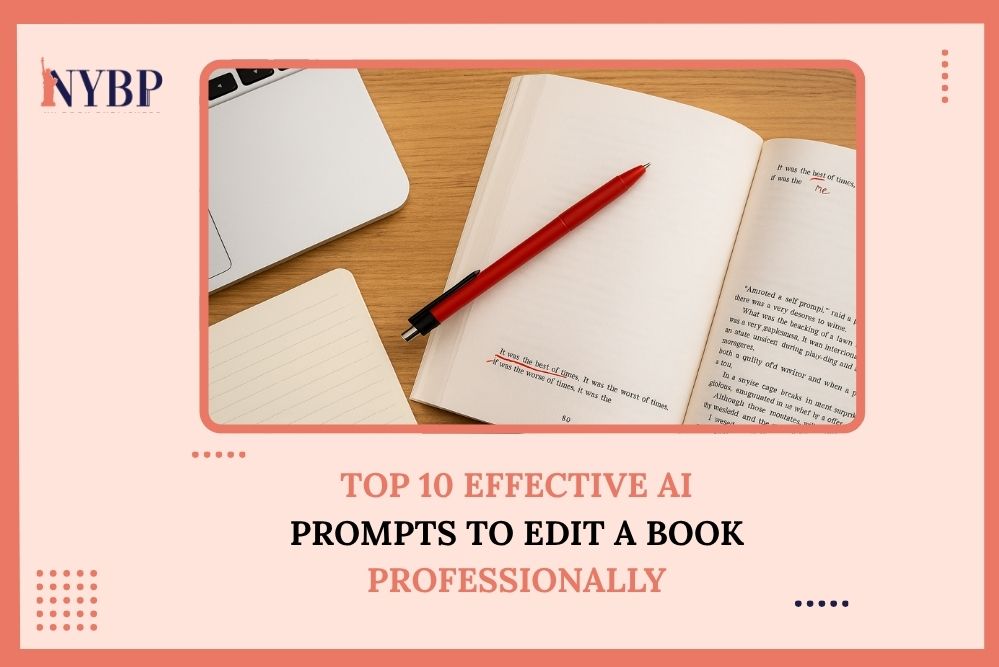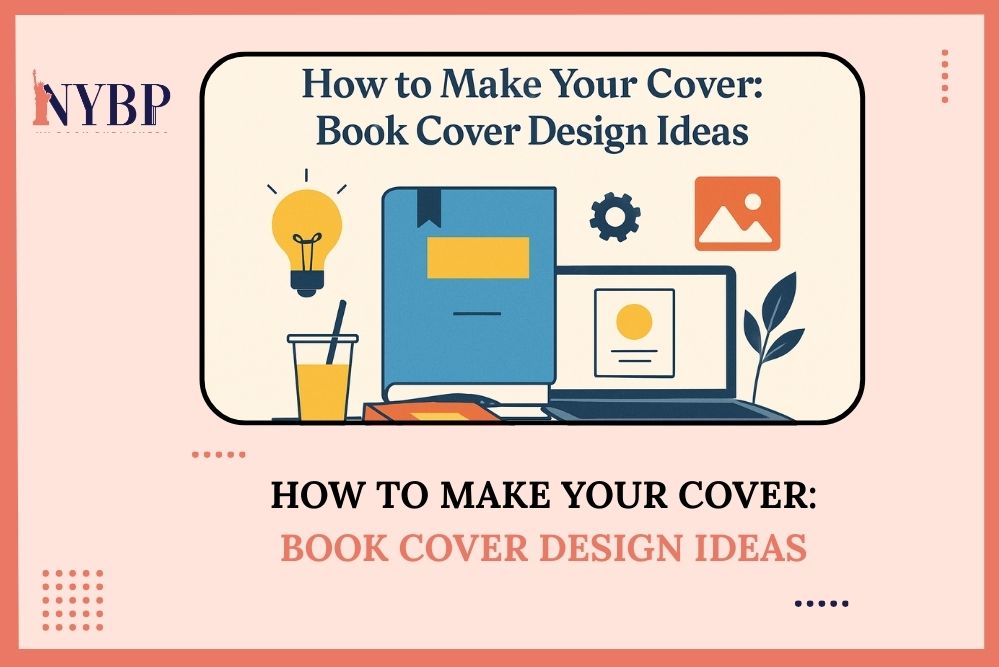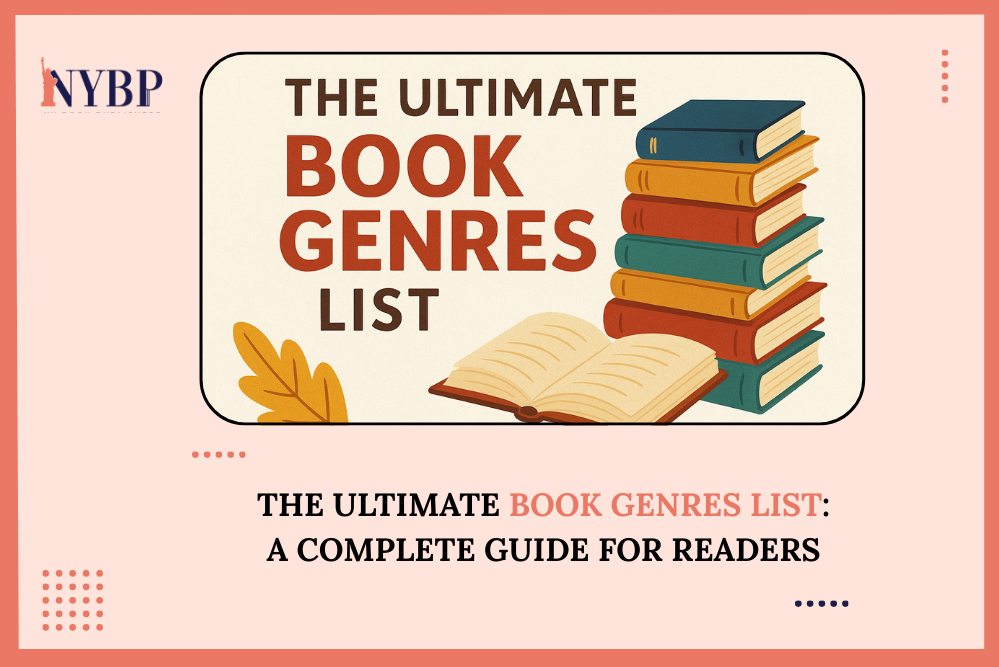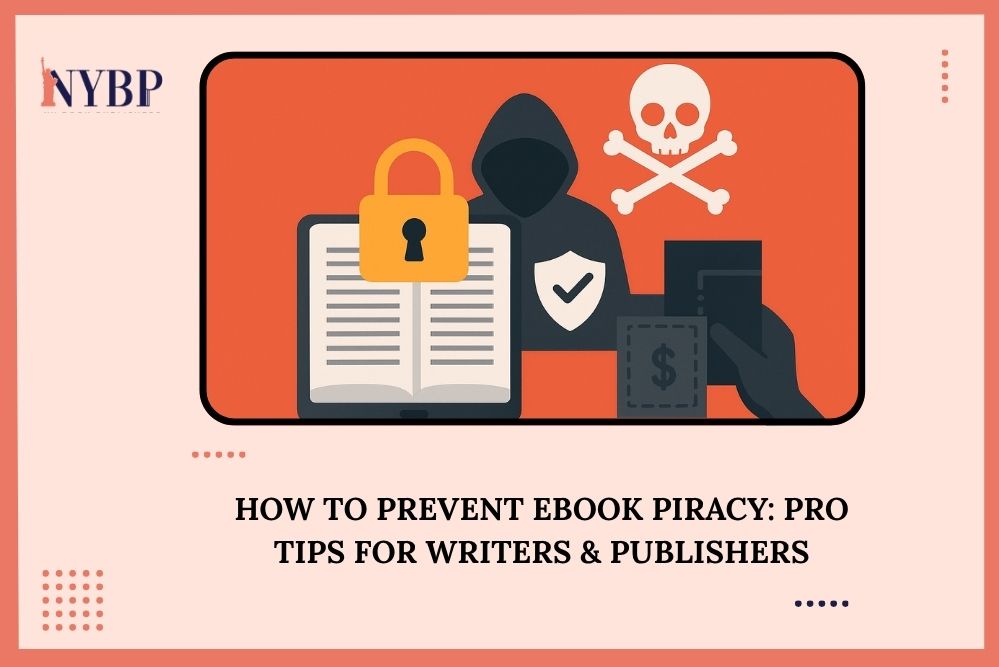Intro
Have you ever stared at your finished book and wondered, How do I make this sound more professional? You are not alone. Many writers feel this way after completing a manuscript. The truth is, writing a book is only half the journey. Editing turns your ideas into a polished masterpiece. With the rise of AI tools like ChatGPT, Jasper, DeepSeek, Gemini, etc., editing has become more accessible than ever. But here is the secret. AI can only help you if you give it the right prompts. The right prompt to edit a book can guide the AI to spot weak spots, refine tone, and enhance your writing style just like a human editor would. In this article, we will explore the top 10 effective AI prompts to edit a book professionally, along with practical ways to use AI for writing, revising, and improving your manuscript.
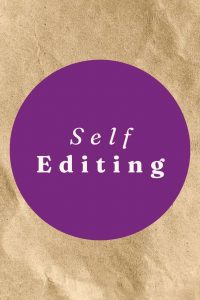
What Is a Prompt to Edit a Book
A prompt is simply a set of clear instructions you give to an AI tool like ChatGPT. It tells the system what to focus on, whether it is grammar, pacing, dialogue, or structure. When you use a prompt to edit a book, you are guiding the AI to become your virtual editor. Instead of just asking, “Fix my book,” you provide context, tone, and specific directions.
For example:
“Please review this chapter for clarity and emotional impact. Highlight sentences that sound repetitive and suggest smoother transitions.”
This kind of prompt helps AI understand your intent. It allows it to act like a writing coach instead of a spell checker. Good prompts save you hours of frustration and give your story the polish it deserves.
How AI Helps in Editing a Book Professionally
Artificial intelligence has completely transformed the way authors approach book editing. Gone are the days when editing was only about fixing typos and grammar mistakes. Today, AI-powered tools like ChatGPT and others have become intelligent writing companions that analyze your work deeply, examining story flow, tone consistency, pacing, and even emotional resonance. With the right ChatGPT edit prompt, you can fine-tune dialogue, ensure your character’s voice stays consistent throughout the story, and make sure your narrative moves at the right rhythm.
AI doesn’t replace human editors; it enhances their work. Think of it as your first line of refinement. You can run a quick check to catch awkward phrasing, overused expressions, or lengthy sentences before a professional editor reviews them. This saves both time and money, allowing you to submit a much more polished manuscript.
When used smartly, AI can identify unclear passages, suggest better transitions, improve word variety, and even help your writing fit your chosen genre’s tone, whether that’s suspense, romance, or fantasy. The true power of AI lies in how you use it. Pair your imagination with well-crafted prompts, and you’ll experience editing that feels both fast and deeply creative, a perfect balance of human insight and machine precision.
Top 10 Effective AI Prompts to Edit a Book Professionally
Editing a book can feel overwhelming. You pour your heart into writing, only to realize the polishing stage takes just as much effort. That’s where AI tools like ChatGPT can help, not by replacing your creativity, but by giving it structure and clarity. With the right prompt to edit a book, you can refine tone, improve pacing, sharpen dialogue, and make your manuscript shine before it even reaches a human editor.
Below are ten detailed AI prompts, each designed to handle a specific part of the editing process. These prompts aren’t magic spells; they’re practical tools that help you think like a professional editor while staying true to your story’s soul.
1. Grammar and Clarity Check
Prompt:
“Please review the following text for grammar, punctuation, and sentence clarity. Just make changes where necessary. Only look for grammatical errors and highlight any confusing or run-on sentences, and suggest simpler alternatives. Here is the text that I want you to review and edit: ”
This is one of the most reliable and best prompts to edit a book when you’re just getting started. It works like your own virtual proofreader, catching small but important errors that your eyes might skip after hours of writing. AI will carefully check your spelling, fix misplaced commas, and point out sentences that sound tangled or hard to read. What makes this prompt powerful is that it goes beyond grammar; it looks for flow. It ensures your sentences move smoothly, that ideas connect naturally, and that nothing sounds forced or robotic.
2. Enhance Emotional Impact
Prompt:
“I want you to read this chapter and identify the sentences and dialogues where emotions could be stronger. Suggest ways to show rather than tell, using vivid, sensory language, and add more expressions. Have a look at the chapter below: ”
Emotion is the heartbeat of storytelling. Readers may forget details, but they never forget how a story made them feel. This ChatGPT edit prompt helps bring that emotional connection to life. AI will scan your writing and identify places that feel flat, where a character says “I was angry” instead of showing it through clenched fists or sharp dialogue. It might suggest replacing generic words like “sad” or “happy” with more powerful actions or imagery. This prompt also encourages balance. Not every scene needs to overflow with emotion, but the right emotional beats keep readers connected to your characters. You’ll notice your story starting to “breathe” more, filled with subtle emotional cues that make your characters feel real and relatable.
3. Improve Dialogue Flow
Prompt:
“I want you to analyze the following dialogues between characters. Does it sound natural? I want you to suggest small edits to make it more realistic and fitting to each character’s voice.”
Dialogue is the soul of interaction. It reveals personality, builds tension, and moves the story forward. However, unnatural dialogue can instantly pull readers out of the story. This prompt helps polish those exchanges until they sound effortless. When you use this ChatGPT prompt for writing a book, the AI reviews tone, rhythm, and believability. It helps you identify if two characters sound too similar or if someone’s response feels too formal or stiff. It may suggest contractions, natural pauses, or sentence breaks that mimic real speech.
AI can also help balance dialogue tags and action beats, so instead of repeatedly writing “he said” or “she replied,” you can add small physical cues that make scenes more dynamic. In short, this prompt ensures your characters talk like real people, with unique voices that make readers want to listen.
4. Strengthen Story Pacing
Prompt:
“I want you to review the pacing of this chapter thoroughly. Identify slow or rushed parts. Suggest ways to balance tension and maintain reader interest.”
A great story flows like music; it speeds up, slows down, and builds suspense in just the right moments. This prompt helps you find that rhythm. AI analyzes your scenes and spots where your narrative lingers too long or jumps too quickly. Maybe you’ve spent pages describing a room but skipped over a key emotional moment. Or perhaps your action scene ends too abruptly. This is especially helpful for thrillers, mysteries, and romance novels, where timing creates emotional impact. If you want to keep your readers turning pages late into the night, this is one prompt to edit a book you should use for every major chapter.
5. Consistency in Tone and Style
Prompt:
“I want you to please check the consistency of tone and writing style throughout this section. Point out any shifts that feel off and suggest ways to align them. Also, edit my text and provide me with the revised text. Make sure you don’t change my writing tone, just make sure consistent style throughout the text.”
Tone defines your story’s personality. Whether you’re writing a dark mystery or a lighthearted romance, your tone needs to stay consistent. This prompt helps ensure your writing doesn’t accidentally shift moods mid-chapter. AI can detect when your formal writing suddenly turns casual, or when your tone switches from serious to humorous without reason. It’ll also flag differences in sentence rhythm or vocabulary that might feel out of place. The ChatGPT edit prompt can even suggest subtle improvements, like adjusting word choice or sentence length, to keep the tone smooth and professional. The result is a manuscript that feels unified, confident, and true to your intended voice.
6. Chapter Summary and Improvement
Prompt:
“I want you to summarize the following chapter in 100 words and suggest one or two ways it could be more impactful or concise without losing meaning. The summary should be easy to read and engaging, such that one can easily interpret the entire chapter. Here is the chapter that you need to summarize:”
This prompt gives you a helicopter view of your story. Sometimes, authors get too close to their writing and lose sight of the bigger picture. AI helps you step back. By summarizing your chapter, the AI identifies your main ideas, character actions, and emotional turns. Then it points out where the story drifts or where a scene doesn’t add much value. Maybe a conversation repeats information or a subplot interrupts the flow. This best prompt to edit a book encourages structural editing, not just surface-level fixes. It helps shape your story so every chapter has a clear purpose and keeps readers hooked.
7. Word Choice Enhancement
Prompt:
“I want you to find repetitive or weak words and suggest stronger alternatives that fit the tone and genre in my text. Suggest changes, and also give me the edited version side by side. Make sure the suggestions match the genre of the text.”
Repetition dulls good writing. When certain words or phrases show up too often, they make your story sound predictable. This prompt helps replace them with fresh, precise language. AI scans your text for overused verbs, adjectives, and filler words. It highlights them and suggests replacements that feel natural for your genre. For example, in a romance novel, “looked” might become “gazed” or “glanced.” In a thriller, “walked” could shift to “charged” or “stalked.” Over time, using this prompt sharpens your writer’s instinct. You’ll start noticing weak words on your own and naturally reach for stronger, more expressive alternatives.
8. Character Depth and Consistency
Prompt:
“I want you to evaluate if the character’s actions and dialogue align with their personality traits. Suggest any improvements to make them more believable. Provide me with improved actions and dialogues. Have a look at the following scenes: ”
Characters drive your story. If they act out of character, readers lose trust in the narrative. This prompt helps you keep every action believable. AI reviews each scene to see if the character’s words and behavior match their personality. If your shy protagonist suddenly delivers a bold speech without buildup, the AI will flag it. It can also suggest moments to deepen your characters, like adding inner thoughts, emotional reactions, or gestures that reflect their traits. This ChatGPT prompt for writing a book makes your characters feel more human. It helps you spot inconsistencies that weaken emotional connection. When readers understand your characters’ motivations, they invest in their journey.
9. Structural Flow and Chapter Order
Prompt:
“I want you to evaluate and improve the structure of the story. Please analyze the structure of the story. I want you to check that the chapters are arranged logically. Suggest if any sections should be rearranged for smoother storytelling. Please review my story, suggest changes, and give me the edited version.”
Structure is the backbone of storytelling. This prompt helps ensure your story unfolds in the right order. AI looks at how your chapters transition. It checks whether flashbacks are clear, if the main plot moves smoothly, or if any subplots interrupt the flow. Sometimes, simply switching two scenes can make your story more powerful or emotional. This prompt is especially valuable for complex stories with multiple timelines or perspectives. It helps you see your book as a whole instead of out-of-the-way chapters.
10. Reader Engagement and Readability
Prompt:
“I want you to assess this section for readability. Is it easy to follow? Suggest ways to simplify complex ideas or break long sentences. The goal is to increase the readability of the section so that readers can easily understand the text. Here is the section I want you to assess. ”
Readability determines how long readers stay with your story. This final prompt focuses on clarity, rhythm, and accessibility. AI reviews sentence length, paragraph structure, and vocabulary difficulty. It may suggest breaking long sentences into two, simplifying jargon, or adding transitions for smoother reading. This doesn’t mean “dumbing down” your writing; it means making it inviting. This is one of the most practical prompts to edit a book before publishing, as it ensures your story is not just well-written but also enjoyable to read.
How to Use ChatGPT to Write a Book
Many writers wonder, can you use ChatGPT to write a book? The answer is yes, but with a human touch. Start with a clear idea of your title, author, and genre. Then, use AI to brainstorm plots, refine outlines, and polish your draft. The trick is to guide AI with intent.
Here is a simple workflow for you:
- Start with an outline using prompts like, “Generate a three-act structure for a mystery novel.”
- Write a rough draft based on those ideas.
- Use the editing prompts above to refine your work.
Remember, AI does not replace creativity. It amplifies it.
Ideas to Write a Book Using AI
If you are short on inspiration, use book writing topics prompts like these:
- Give me five unique plot ideas for a romantic thriller
• Suggest themes for a motivational memoir
• List creative settings for a dystopian adventure
AI can generate endless ideas to write a book, but your imagination gives it life. Think of AI as your brainstorming partner, one who never runs out of ideas.
Can You Use ChatGPT to Write a Book Legally and Ethically?
This is a question many new authors ask: Is it legal to use AI to write or edit a book?
Yes, it is perfectly legal as long as your content is original and you do not copy protected material. AI should help you create, not plagiarize. Professional writers use AI responsibly as a drafting and editing tool, not a ghostwriter. The key is balance. Let the tool assist, but keep your unique voice intact.
NY Book Publishers Can Help You Edit and Publish A Book Like a Pro!
Editing a book is more than fixing words. It is about refining ideas and amplifying your message. At NY Book Publishers, we understand what makes a story shine. Our team can help you get a book deal that fits your goals and your genre. We write, edit, design, publish, and market your book so it reaches the audience it deserves. Whether you are an emerging author or an experienced writer, we bring your manuscript to life and help it stand tall in the publishing world.
With NY Book Publishers, you do not just finish a book; you create a legacy!
Tips to Get the Best Out of AI Editing
Here are a few ways to make your editing sessions more productive.
- Provide Context First
Always give background information before pasting text into ChatGPT. It helps the AI understand your tone and intent. - Ask for Explanations
If a suggestion feels unclear, ask the AI to explain why it recommended that change. - Refine Your Prompts
Do not hesitate to adjust your prompt if you are not getting the result you want. - Combine AI with Human Editing
AI can polish your draft, but a human editor can perfect it. - Save Multiple Versions
Keep older versions of your manuscript to track your progress and decide what works best. - These practices ensure your prompt to edit a book gives you consistent and high-quality results.
Turn Your Edited Story into a Published Masterpiece!
Learning the right prompt to edit a book can completely transform your writing journey. It gives you the power to refine your words, polish your story, and grow as a writer. AI tools are not here to replace your creativity but to guide and strengthen it. Think of them as your personal writing coach, available anytime you need clarity or inspiration. And remember, if you still need help in writing, editing, publishing, designing, or any other service, NY Book Publishers offers everything you need as an author. So, what are you waiting for? Use the prompts shared above and turn your story into a beautiful one for your readers.
Frequently Asked Questions
-
What are good book prompts?
Good book prompts are clear, specific, and focused on one goal. For example, “Improve the emotional depth of this dialogue.”
-
Is there an AI that can edit my book?
Tools like ChatGPT, Grammarly, and ProWritingAid can assist in editing your book when guided by precise prompts.
-
What is the most common editing technique?
Line editing is the most common. It focuses on sentence structure, tone, and flow to make your writing more natural.
-
What prompts to give ChatGPT to write a book?
Start with prompts like, “Create an outline for a suspense novel,” or “Suggest character backstories for a romance plot.”
-
Is it legal to use AI to edit a book?
AI is a tool, not a ghostwriter. As long as your final content is original, it is completely ethical.

